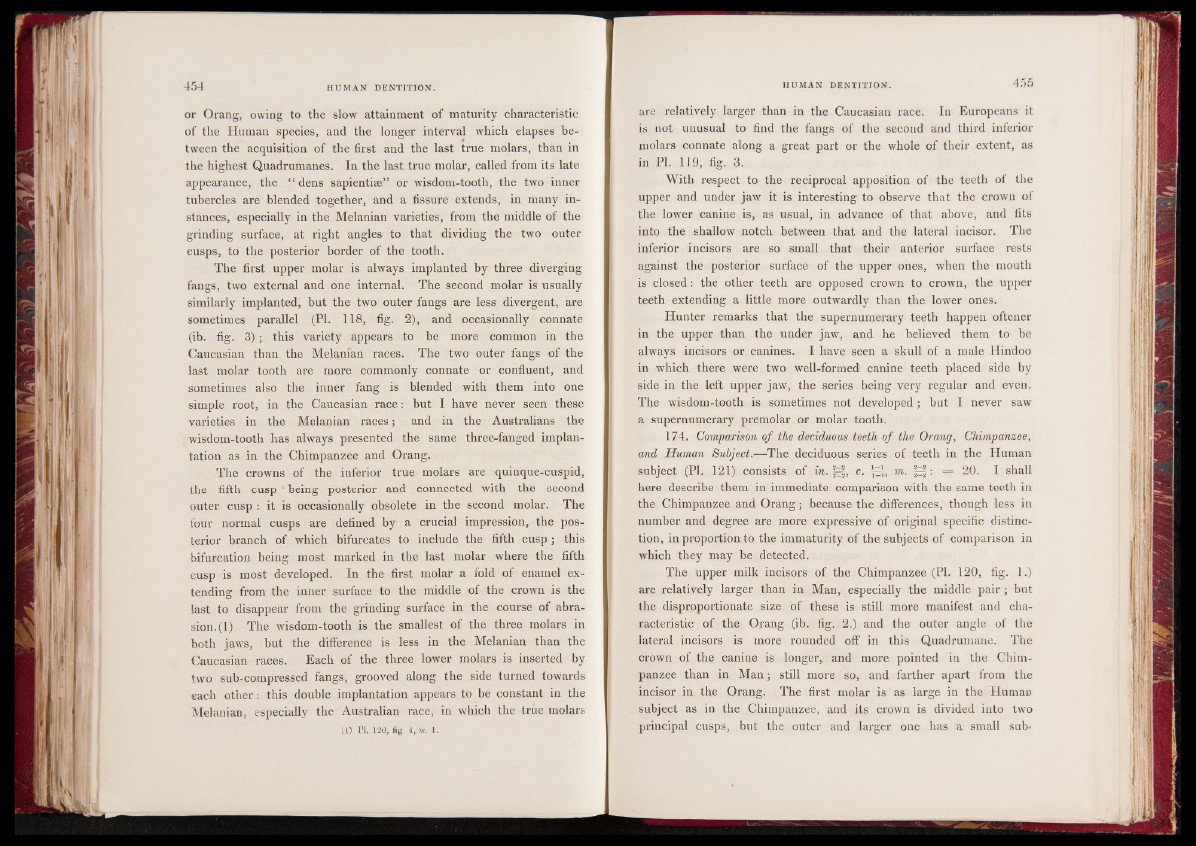
or Orang, owing to the slow attainment of maturity characteristic
of the Human species, and the longer interval which elapses between
the acquisition of the first and the last true molars, than in
the highest Quadrumanes. In the last true molar, called from its late
appearance, the “ dens sapientire” or wisdom-tooth, the two inner
tubercles are blended together, and a fissure extends, in many instances,
especially in the Melanian varieties, from the middle of the
grinding surface, at right angles to that dividing the two outer
cusps, to the posterior border of the tooth.
The first upper molar is always implanted by three diverging
fangs, two external and one internal. The second molar is usually
similarly implanted, hut the two outer fangs are less divergent, are
sometimes parallel (PI. 118, fig. 2), and occasionally connate
(ib. fig. 3); this variety appears to be more common in the
Caucasian than the Melanian races. The two outer fangs of the
last molar tooth are more commonly connate or confluent, and
sometimes also the inner fang is blended with them into one
simple root, in the Caucasian race: but I have never seen these
varieties in the Melanian races; and in the Australians the
wisdom-tooth has always presented the same three-fanged implantation
as in the Chimpanzee and Orang.
The crowns of the inferior true molars are quinque-cuspid,
the fifth cusp ' being posterior and connected with the second
outer cusp : it is occasionally obsolete in the second molar. The
four normal cusps are defined by a crucial impression, the posterior
branch of which bifurcates to include the fifth cusp ; this
bifurcation being most marked in the last molar where the fifth
cusp is most developed. In the first molar a fold of enamel extending
from the inner surface to the middle of the crown is the
last to disappear from the grinding surface in the course of abrasion.
(1) The wisdom-tooth is the smallest of the three molars in
both jaws, but the difference is less in the Melanian than the
Caucasian races. Each of the three lower molars is inserted by
two sub-compressed fangs, grooved along the side turned towards
each other: this double implantation appears to be constant in the
Melanian, especially the Australian race, in which the true molars
(1) PI. 120, tig, 4, m, 1.
are relatively larger than in the Caucasian race. In Europeans it
is not unusual to find the fangs of the second and third inferior
molars connate along a great part or the whole of their extent, as
in PI. 119, fig. 3.
With respect to the reciprocal apposition of the teeth of the
upper and under jaw it is interesting to observe that the crown of
the lower canine is, as usual, in advance of that above, and fits
into the shallow notch between that and the lateral incisor. The
inferior incisors are so small that their anterior surface rests
against the posterior surface of the upper ones, when the mouth
is closed: the other teeth are opposed crown to crown, the upper
teeth extending a little more outwardly than the lower ones.
Hunter remarks that the supernumerary teeth happen oftener
in the upper than the under jaw, and he believed them to be
always incisors or canines. I have seen a skull of a male Hindoo
in which there were two well-formed canine teeth placed side by
side in the left upper jaw, the series being very regular and even.
The wisdom-tooth is sometimes not developed; but I never saw
a supernumerary premolar or molar tooth.
174. Comparison of the deciduous teeth of the Orang, Chimpanzee,
and Human Subject.—The deciduous series of teeth in the Human
subject (PI. 121) consists of in. |e|, c. £-{, m. |E§: = 20. I shall
here describe them in immediate comparison with the same teeth in
the Chimpanzee and Orang; because the differences, though less in
number and degree are more expressive of original specific distinction,
in proportion to the immaturity of the subjects of comparison in
which they may be detected.
The upper milk incisors of the Chimpanzee (PI. 120, fig. 1.)
are relatively larger than in Man, especially the middle pair ; but
the disproportionate size of these is still more manifest and characteristic
of the Orang (ib. fig. 2.) and the outer angle of the
lateral incisors is more rounded off in this Quadrumane. The
crown of the canine is longer, and more pointed in the Chimpanzee
than in Man; still more so, and farther apart from the
incisor in the Orang. The first molar is as large in the Humar
subject as in the Chimpanzee, and its crown is divided into two
principal cusps, but the outer and larger one has a small sub'